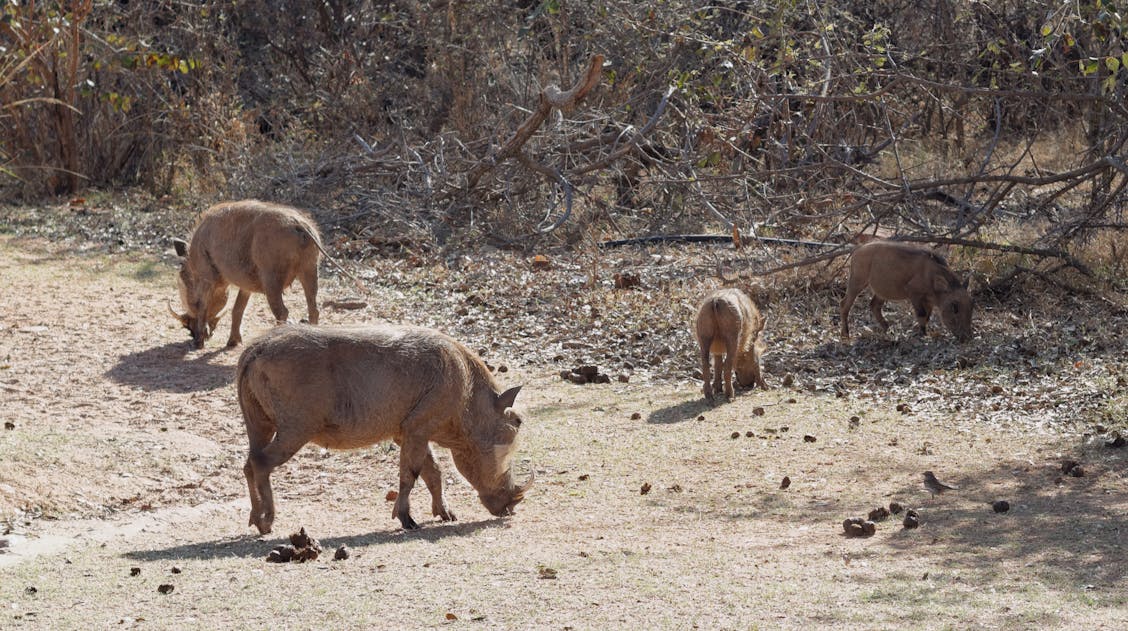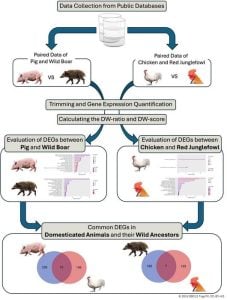
Exploring Genetic Traits of Domestication in Chickens and Pigs
Population increase is putting a serious strain on food production and is set to cause even more pressure in the future. Because of this, food price inflation remains high globally, according to the World Bank Group:
“Inflation higher than 5% is experienced in 59.1% of low-income countries, 63% of lower-middle-income countries, 36% of upper-middle-income countries, and 10.9 percent of high-income countries.”
Increases in food prices limit access to food for vulnerable people and families. Improving food production efficiency has the power to decrease the inflation in food prices. Ensuring that we can meet this demand is a challenge. Researchers from Hiroshima University in Japan published their research in Open Access journal Animals exploring how domestication of chickens and pigs may have led to selective breeding in these species, decreasing their reproductive capacity.
Easing the strain on food production
Chickens and pigs are important protein sources for humans. Domesticated from wild boars and red jungle fowl, they have been brought under human control and selectively bred for human benefit. This includes increasing growth rates and improving meat quality.
However, this domestication has influenced the animal’s behaviour, morphology, and physiological functions at a genetic level. Furthermore, selective breeding has direct links to health issues and decreases in reproductive capacity in domesticated animals. The researchers hypothesise that understanding changes in gene expression caused by domestication could help to improve the efficiency of livestock breeding. This would increase the availability of these food products, helping to ease the strain on food production. In this article, we explore this research and how researchers could use it to select target genes that enable healthier and more productive livestock breeding.
Wild animals vs. domesticated at the genetic level
The genes of domesticated animals such as pigs and chickens differ significantly from those of their ancestors. This is due to their lifestyles and habitats being extremely different. For example, farmers often breed chickens and pigs in confined, limited spaces at high densities. In these conditions, illnesses and infections can easily spread. Because of this, domestic animals such as pigs and chickens often see increased expression of genes involved in the immune response to protect against these illnesses.
Furthermore, wild animals frequently experience stress in their everyday lives. This includes physical trauma, food shortages, and being pursued as prey. Humans raise domesticated animals in stress-free environments to enhance certain traits
Stress can have negative implications for the quality of the meat, reducing its water-binding capacity and producing tougher meat. It can negatively impact the growth rate of the animal producing less meat.
“Through domestication, these animals have been brought under human control and have been selectively bred for specific traits useful to humans, such as faster growth rates, improved meat quality, and increased litter size,” says Professor Dr. Hidemasa Bono, author of the paper.
The researchers investigated how domestication impacts the genetics of these animals. This was to further the understanding of this type of evolution and how to enhance these preferred genes to increase food production.
“This process has significantly altered the animals’ behaviour, morphology, and physiological functions. … While the selection for traits beneficial to humans has occurred, excessive selective breeding has led to health issues in domesticated animals and decreased their reproductive capacity. To address these issues, it is crucial to understand the changes in gene expression between domesticated animals and their wild ancestors.” – Professor Dr. Hidemasa Bono, author of the paper.
Comparing genetic differences between descendants and ancestors
The researchers used publicly available data to collect RNA sequence data of pigs, chickens and their ancestors red jungle fowl and wild boars. They quantified the gene expression, and calculated the expression ratio between domesticated animals and their wild ancestors (DW-ratio). The genes were then classified as upregulated, downregulated, or unchanged based on their DW-ratio score. Upregulation is when a gene is highly expressed. Downregulation is the opposite – it is a decrease in gene expression. The researchers identified that 240 upregulated genes in pigs and 206 upregulated genes in chickens to their ancestors, red junglefowl and wild boars.
The researchers identified that 10 genes were upregulated in both pigs and chickens. In addition, they also identified that 7 genes were upregulated in both wild boars and jungle fowl.
“Notably, domesticated animals exhibited higher expression of genes related to viral resistance and bone weakness, whereas their wild ancestors showed higher expression of genes associated with stress response and energy metabolism,” – Motoki Uno, author of the paper.

How gene upregulation improves meat production
The researchers noted that pigs upregulated genes commonly associated with muscle development and fat accumulation. Additionally, they identified that genes involved in viral or bacterial infections were also upregulated.
However, in chickens, they identified that genes associated with aminoglycan catabolic process and carbohydrate derivative catabolic process were upregulated. These processes both promote bone and joint healing.
This suggests that chickens are experiencing bone weakness. The researchers suggest that this could be due to increased growth rates where chickens have increased weight to support.
“Our analysis revealed that genes commonly upregulated in pigs and chickens are involved in the immune response, olfactory learning, epigenetic regulation, cell division, and the extracellular matrix, which is the molecular structure that gives support to cells and tissues in an organism. In contrast, genes upregulated in wild boar and red junglefowl are related to stress response, cell proliferation, cardiovascular function, neural regulation, and energy metabolism.” – Motoki Uno.
The researchers conclude that the genes commonly upregulated across domesticated species suggest a strong association with the domestication process. Furthermore, they state that these genes could be potential targets for improving breeding and increasing food production. Additionally, researchers should apply these candidate genes to efficient breeding programs using genome editing techniques.
“These findings provide valuable insights into the genetic basis of the domestication process and highlight potential candidate genes for breeding applications. Moving forward, we aim to contribute to sustainable breeding through the improvement of analytical methods and the integration of various biological data.” – Professor Dr. Hidemasa Bono
If you would like to read more about how biotechnology can be used to improve livestock methods or would like to submit research in this area, please see our recent Special Issue: Biotechnology and Bioinformatics in Livestock











Wow, this post is a fascinating read! Exploring the genetic traits of domestication in chickens and pigs provides such an insightful look into how these animals have evolved alongside humans. The detailed analysis of genetic changes and their impact on domestication is truly impressive. It’s amazing to see how genetics has shaped the traits we observe in these animals today. Thank you for this enlightening and well-researched article!
Hi,
Thank you for your comment. We removed the link from your comment, I hope this is okay.
All the best.